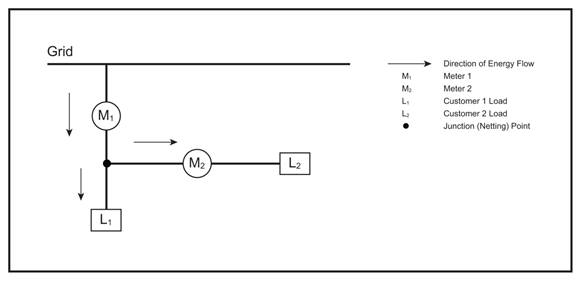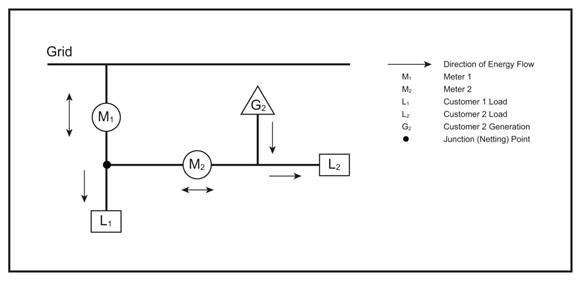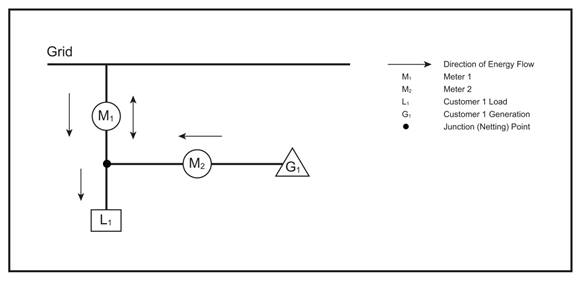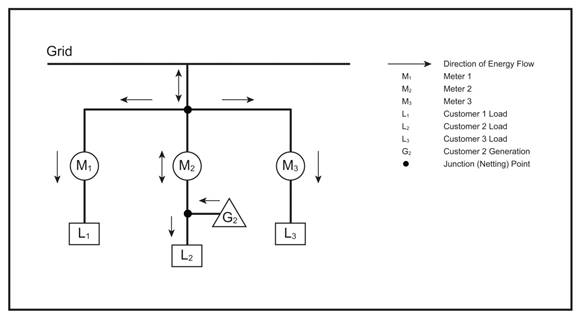The copy of this document located on Measurement Canada's website is considered to be the controlled copy.
Category: Electricity
Issue Date:
Effective Date :
Revision number: 2
Supersedes : E-27 (rev. 1)
Table of contents
- 1.0 Purpose
- 2.0 Scope
- 3.0 References
- 4.0 Background
- 5.0 Connection configurations
- 6.0 Deductive totalizing
- 7.0 Net and deductive measurement policy
- 8.0 Parallel measurement
- 9.0 Electromechanical meters
- 10.0 Revisions
- Appendix 1—Diagrams of net and deductive measurement configurations
- Appendix 2—Examples of net error impact
1.0 Purpose
The purpose of this bulletin is to communicate Measurement Canada's (MC) policy on net quantity values declared in electricity trade transactions comprising the transfer of both delivered and received energy.
2.0 Scope
This bulletin applies to all quantities declared as net measurement values that are used to establish the basis of a charge for active and reactive energy.
3.0 References
- S-E-05—Specification for Approval of Type of Electronic Meters–Net Metering
- S-E-08—Specifications for the Installation and Use of Electricity Meters – Standard Drawings for Electricity Metering Installations
- In-Series Metering Connection Configurations — Ontario Power Authority Feed-In-Tariff Program
- Electricity and Gas Inspection Act
- Electricity and Gas Inspection Regulations
4.0 Background
In 2007, MC issued this bulletin, which established the policy for granting a temporary permission for the use of electromechanical meters in net metering applications. This permission expired on December 31, 2013.
In 2008, MC issued specification S-E-05, which establishes criteria for the approval of meters providing a net registration. These criteria were established on the premise that any measurement error of the meter would be of the same magnitude for energy registered in the received direction as for energy registered in the delivered direction.
MC discovered that electricity metering installations configured to use net measurement methods can result in quantity declarations for a net value that exceeds legislated tolerances under certain conditions. A net value will be inaccurate when the error of energy registration in the received direction is different than the error of energy registration in the delivered direction. The extent of inaccuracy attributed to a net value is dependent on the following characteristics: connection configuration, load directions, load ratio and individual meter errors.
5.0 Connection configurations
5.1 In-series connection configuration
This type of connection configuration (see Appendix 1, diagrams 1, 2 and 3) is one whereby two or more distinct electricity loads and/or generators (two or more distinct purchasers and/or sellers from the perspective of the Electricity and Gas Inspection Act [EGIA]) are connected to the common electricity grid in the following manner:
- one meter is connected between the grid and a junction point between two or more loads,
- one meter is connected between the junction point and one of the loads, and
- no meter is connected between the junction point and the other load.
The energy attributed to the non-metered load is not measured, but calculated using a deductive totalizing method.
5.2 Parallel connection configuration
This type of connection configuration (see Appendix 1, diagram 4) is the typical manner in which multiple distinct purchasers and/or sellers (i.e. loads and/or generators) are metered and connected to a common electricity grid. Each distinct load and generator is connected to the grid through individual meters with no common interconnection on the non-grid side of the meters.
6.0 Deductive totalizing
6.1 Description
Deductive totalizing (as defined in S-E-08) is a manner of deductive summation used with an in‑series connection configuration. This manner of summation is used to determine a non‑metered load indirectly by subtracting the value of all metered loads from the value of the total metered load. The calculated non-metered load value corresponds to the declared net value.
6.2 Inaccuracy
Deductive totalizing can result in quantity declarations for the non-metered load that exceed legislated tolerances under certain conditions. The extent of inaccuracy is dependent on load directions, load ratio and individual meter errors.
6.3 Impact of inaccuracy
It is known that as the magnitude of error between the declared net value and the true net value increases, the impact of the error decreases because the true net value also decreases in relation to the total value of energy transacted. In addition, as the true net value increases, the magnitude of error between the declared net value and the true net value decreases (see Appendix 2 for practical examples).
7.0 Net and deductive measurement policy
7.1 General
With regard to subsection 6.3, it can be concluded that the error in declared values is sufficiently low such that Measurement Canada will permit a net value declaration subject to certain conditions. MC will place priority on the accuracy of the actual meter values declared pursuant to those conditions.
7.2 Unidirectional energy flow, multiple customers
This type of connection configuration (see Appendix 1, diagram 1) refers to an electricity connection configuration, as described in section 5.1, in which the loading from the grid is attributed to multiple distinct customers (that is, each customer has a distinct account with the supplier). All customers only consume energy from the grid, they do not generate any energy to the grid.
As per section 10.2 of S-E-08, deductive totalizing in this context is not permitted.
7.3 Bidirectional energy flow, multiple customers
This type of connection configuration (see Appendix 1, diagram 2) refers to an electricity connection configuration, as described in subsection 5.1, in which the loading from the grid and generation to the grid is attributed to two or more distinct customer accounts with the grid deemed the supplier as a point of reference. A net value is calculated for a non‑metered point using the values of the actual meter readings.
7.3.1 Net value declaration
Declaration, for billing purposes, of a calculated net value for the non-metered junction point is permitted subject to the following conditions:
- All coincident register readings (current and previous) for each meter and each respective consumed (delivered) energy value are provided on the quantity declaration statements (invoices) in addition to the net declared value for each legal unit of measure (LUM) traded.
- The supplier (grid) makes the following quantity declarations for each LUM traded:
- value of LUM charged to the generating customer (meter 2 registration of delivered energy);
- value of LUM charged to the consuming customer (meter 1 registration of delivered energy);
- value of LUM charged to the consuming customer (meter 2 registration of received energy);
- value of LUM credited to the consuming customer (meter 1 registration of received energy);
- value of LUM credited to the consuming customer (meter 2 registration of delivered energy);
- value of LUM credited to the generating customer (meter 2 received energy registration).
Note: Meter 1 is the meter connected between the grid and the junction point.
Meter 2 is the meter connected between the junction point and either the loading or generating customer.
The purpose of making six distinct LUM quantity declarations in the manner indicated above is that each declaration is considered a trade transaction and deviation (from true value) for each transaction value must not exceed that of the individual meter error.
7.3.2 Net quantity declaration
As an alternative to 7.3.1, the declaration of a calculated net quantity for the non‑metered junction point is permitted subject to the following conditions:
- All coincident meter register readings (current and previous) for each meter and each respective consumed (delivered) energy value are provided on the quantity declaration statements (invoices) in addition to the net declared value for each LUM traded.
- Quantity declaration statements (invoices) include the following disclaimer:
"Net quantity values declared on this statement may not comply with the accuracy requirements of the EGIA where the ratio of delivered energy (from the grid) to received energy (to the grid) is less than 2:1".
Note: It has been mathematically confirmed that when meter registration errors are no more than ±1.0% (the MC verification tolerance) and the ratio of delivered energy to received energy is greater than 2:1, the error in net quantity declared must not exceed ±3.0% (the legal limit pursuant to the Electricity and Gas Inspection Regulations).
7.4 Bidirectional energy flow, single customer
This type of connection configuration (see Appendix 1, diagram 3) refers to an electricity connection configuration, as described in section 5.1, in which the loading from the grid and generation to the grid is attributed to one customer with the grid deemed the supplier as a point of reference. While there is only one customer in this case, there may be two customer accounts due to the separation (in load settlement) of customer generation and customer load. In this connection configuration, the only declared values that are necessary to determine the customer's energy use (consumption) and generation are the values provided by meter 1. However, for the purposes of load settlement, meter 2 may be used in this configuration to establish LUM values that are part of a trade transaction.
7.4.1 Net value declaration
Declaration (for billing purposes) of a calculated net value for the non-metered junction point is permitted subject to the following conditions:
- All coincident meter register readings (current and previous) for each meter and each respective consumed (delivered) energy value are provided on the quantity declaration statements (invoices) in addition to the declared net value for each LUM traded.
- The supplier (grid) makes the following quantity declarations for LUM traded:
- value of LUM charged to the customer (meter 2 registration for delivered energy);
- value of LUM charged to the customer (meter 1 registration for delivered energy);
- value of LUM charged to the customer (meter 2 registration for received energy);
- value of LUM credited to the customer (meter 1 registration for received energy);
- value of LUM credited to the customer (meter 2 registration for delivered energy);
- value of LUM credited to the customer (meter 2 registration for received energy).
Note: Meter 1 is the meter connected between the grid and the junction point.
Meter 2 is the meter connected between the junction point and the generator.
The purpose of making six distinct LUM quantity declarations in the manner indicated above is that each declaration is considered a trade transaction and any deviation (from true) for each transaction value must not be larger than that of the individual meter error. In this case, since the customer and the generator are the same party, the six LUM quantity declarations identified in 7.4.1(b) may be combined (added) as follows:
- value of LUM charged to the customer (meter 2 delivered energy registration, plus meter 1 delivered energy registration, plus meter 2 received energy registration);
- value of LUM credited to the customer (meter 1 received energy registration, plus meter 2 delivered energy registration, plus meter 2 received energy registration).
7.4.2 Net quantity declaration
As an alternative to 7.4.1, the declaration of a calculated net quantity for the non-metered junction point is permitted subject to the following conditions:
- All coincident meter register readings (current and previous) for each meter and each respective consumed (delivered) energy value are provided on the quantity declaration statements (invoices) in addition to the net declared value for each LUM traded.
- The quantity declaration statements (invoices) include the following disclaimer: "Individual net quantity values declared on this statement may not comply with accuracy requirements of the EGIA where the ratio of delivered energy (from the grid) to received energy (to the grid) is less than 2:1. However, the aggregated value of the individual measured quantities will remain in compliance".
Note: The disclaimer in 7.4.2 (b) differs from that of 7.3.2 (b) due to the fact that the two customer accounts are attributed to only one customer. This means that some of the six quantity declaration errors will offset each other, resulting in an aggregate error equal to or less than the meter errors.
7.5 Unidirectional energy flow, single customer (deductive totalizing)
This type of connection configuration (see Appendix 1, diagram 5) refers to an electricity connection configuration, as described in section 5.1, in which the loading from the grid is attributed to one customer with the grid deemed the supplier as a point of reference. While there is only one actual customer in this case, there may be two or more customer loads. In this connection configuration, the only declared values that are necessary to determine the usage of the customer are the values provided by meter 1. However, for the purpose of rate settlement, meter 2, 3, etc. may be used in this configuration to establish LUM values that are part of the overall trade transaction.
As per S-E-08, deductive totalizing in this context is permitted.
7.6 Transition period
As of January 1, 2015, a transitional period of one year is granted to electricity sellers that make net quantity declarations to satisfy the conditions of sections 7.3 and 7.4, as applicable.
8.0 Parallel measurement
Parallel measurement precludes the establishment of a value for a LUM at a non-metered point. No net or deductive totalized values are established and therefore the policy requirements of section 7.0 are not applicable.
9.0 Electromechanical meters
he temporary permission to use electromechanical meters in net measurement applications expired on December 31, 2013. As of January 1, 2014, any meter used for net measurement must be of a type approved for providing a net registration or a registration in both directions.
10.0 Revisions
The purpose of this revision 2 was to:
- include acceptance of deductive totalizing for single customer applications where discrete meters could be used for distinct rate application to separate loads, in order to facilitate dual‑energy systems in residential, commercial and institutional environments, thereby reducing greenhouse gas (GHG) emissions;
- add diagram 5 to illustrate an electricity connection configuration for a single customer where there are multiple customer loads and only one customer load isn't directly measured by a meter;
- update the format of the document in accordance with the latest formatting requirements.
The purpose of revision 1 was to:
- communicate that the temporary permission to use electromechanical meters in net metering applications expired on December 31, 2013;
- establish MC's policy regarding the use of deductive calculations in a net measurement context.
Appendix 1—Diagrams of net and deductive measurement configurations
Diagram 1: Unidirectional energy flow, multiple customers

This diagram illustrates an electricity connection configuration, as described in section 5.1, in which the loading from the grid is attributed to multiple distinct customers (that is, each customer has a distinct customer account with the supplier). All customers only consume energy from the grid, they do not generate any energy to the grid.
Diagram 2: Bidirectional energy flow, multiple customers (in-series metering)

This diagram illustrates an electricity connection configuration, as described in section 5.1, in which the loading from the grid and generation to the grid is attributed to two or more distinct customer accounts with the grid deemed the supplier as a point of reference. A net value is calculated for a non-metered point using the values of the actual meter readings.
Diagram 3: Bidirectional energy flow, single customer

This diagram illustrates an electricity connection configuration, as described in section 5.1, in which the loading from the grid and generation to the grid is attributed to one customer with the grid deemed the supplier as a point of reference. While there is only one actual customer in this case, there may be two customer accounts due to the separation (in load settlement) of customer generation and customer load. In this configuration, the values provided by meter 1 are the only declared values needed to determine the customer's energy use (consumption) and generation. However, for the purposes of load settlement, meter 2 may be used in this configuration to establish LUM values that are part of a trade transaction.
Diagram 4: Bidirectional energy flow, multiple customers (parallel metering)

This diagram illustrates parallel metering, which is the typical manner in which multiple distinct purchasers and sellers (i.e. loads and generators) are metered and connected to a common electricity grid. Each distinct load and generator is connected directly to the grid through individual meters with no common interconnection on the non-grid side of the meters.
Diagram 5: Unidirectional energy flow, single customer (deductive totalizing)

This diagram illustrates an electricity connection configuration, as described in section 5.1, in which the loading from the grid is attributed to one customer with the grid deemed the supplier as a point of reference. While there is only one actual customer in this case, there may be two or more customer loads. In this connection configuration, the only declared values that are necessary to determine the usage of the customer are the values provided by meter 1. However, for the purposes of rate settlement, other meters (2, 3, etc.) may be used in this configuration to establish LUM values that are part of the overall trade transaction.
Appendix 2—Examples of net error impact
Example 1: Large net error, small net value
A meter has an error of +0.2% in delivered direction and of -0.4% in received direction.
If the total energy delivered is 20 000 Wh and the total energy received is 19 500 Wh, the true net value is 500 Wh.
In this case, the meter would register 20 040 Wh delivered and 19 422 Wh received. The net value registered by the meter would be 618 Wh. The error between the declared net value and the true net value is +23.6%.
In considering the relative amount of the net energy declared compared to the total amount of the energy transaction between the two parties (500 Wh out of a total of 20 000 Wh), the impact of the error in net value is relatively insignificant. From that perspective, the error is 118 Wh out of a total of 20000 Wh or 0.59% when expressed as a percentage. The net error is large (well in excess of the tolerances prescribed in the EGIA), but the impact on the total transaction is small.
Example 2: Large net value, small net error
A meter has an error of +0.2% in delivered direction and of -0.4% in received direction.
If the total energy delivered is 20 000 Wh and the total energy received is 11 000 Wh, the true net value is 9000 Wh.
In this case, the meter would register 20 040 Wh delivered and 10 956 Wh received. The net value registered by the meter would be 9084 Wh. The error between the declared net value and the true net value is +0.93%.
As the net value increases, the net error decreases to well within tolerances prescribed in the EGIA.
